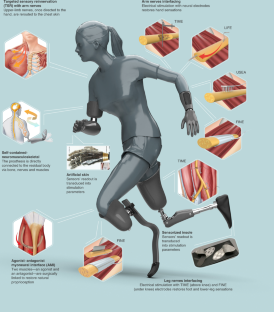Archives: Enciclopedias ART LAB

High arch is the opposite of flat feet
High arch: High arches are a genetically inherited condition where your arch is much higher or raised than normal. When weight-bearing, there is significantly more space in between the floor and the arch.

Flat feet can cause pain and affect walking
Flatfoot is a condition in which the longitudinal arch of the foot is lost. It also involves abduction of the forefoot and valgus deformity of the hind foot. In flexible flatfoot, the arch is present during non–weight bearing but is lost during weight bearing. In rigid flatfoot, the arch is absent in weight-bearing and non–weight-bearing positions.

Leg or foot amputation
Leg or foot amputation is the removal of a leg, foot or toes from the body. These body parts are called extremities. Amputations are done either by surgery.

Microtia
Microtia and Atresia are congenital birth defects of the ear. Microtia is when the outer ear does not fully develop during the first trimester of pregnancy or when the outer ear is absent, (known as anotia). Atresia is the absence of the ear canal, resulting in hearing loss. Microtia and Atresia occurs in every 1 out of 6,000 to 12,000 births.

Prostheses for various types of amputations
When talking about prosthetics and artificial limbs, it’s important to note the differences between the various types and their specific uses. There are usually four main types to consider: transradial, transfemoral, transtibial, and transhumeral. However, other prosthetics can be used in certain conditions.

Orthopedic devices
Orthotic devices, also called orthoses, are external devices put on the body to correct abnormal bone and muscle structure and function.

Clinodactyly
Clinodactyly is a medical term describing the curvature of a digit (a finger or toe) in the plane of the palm, most commonly the fifth finger (the “little finger”) towards the adjacent fourth finger (the “ring finger”).

Wetware
The meaning of WETWARE is the human brain or a human being, considered especially with respect to human logical and computational capabilities.

Transhumanism
Transhumanists believe death is only temporary, they believe in a future of human immortality.

Breast cancer in men
Both men and women have breast tissue In men, most breast tissue is located behind the nipple. Women have a lot more breast tissue than men – and a much higher rate of breast cancer. Cancers can, however, occur in male breast tissue. Breast cancer is uncommon in men. The average age at diagnosis is 71 years old. As our population ages, it is therefore increasingly important to provide information and support to affected men and their families. Since there are relatively few cases of breast cancer in men compared to women, there is less information and research focused specifically on male breast cancer. As a result, treatment decisions for male breast cancer are often based on studies of breast

Gangrene
Gangrene happens when tissues in your body die after a loss of blood caused by illness, injury, or infection. It usually happens in extremities like fingers, toes, and limbs, but you can also get gangrene in your organs and muscles. There are different types of gangrene, and all of them need medical care right away.

Tetra-amelia syndrome
Tetra-amelia syndrome (sometimes known as TETAMS) is a very rare disorder characterized by the absence of all four limbs.

Ectrodactyly
Ectrodactyly-Ectodermal Dysplasia-Clefting Syndrome (EEC) EEC syndrome, there are three different forms of EEC: EEC type 1, 2 and 3. Only one family has been identified with EEC 1 and 2. The most common type is EEC 3. Ectrodactyly ectodermal dysplasia cleft lip/palate (EEC) syndrome is a rare genetic disorder. Symptoms can vary greatly from one person to another. Affected individuals often have abnormalities affecting the limbs, including ectrodactyly, a condition in which part or all of the central digits (fingers or toes) are missing. Ectrodactyly often affects the middle fingers or toes, but can present differently in different people (or be absent altogether). A groove or gap in the upper lip (cleft lip) and a groove or gap in the roof

Limb difference
“Limb” is another name for the arms or legs. Limb differences are when an arm or leg is not shaped in the usual way. For example, a child’s legs may be curved or one might be shorter than the other. Or, a bone in the arm may be short or missing. A limb difference that a child is born with is called congenital. A limb difference that happens after birth is called acquired.

Horse accident leads for amputation
Head injuries are the most common reason for admission to hospital or death among riders. Sobering statistics reveal the high percentage of equine-related accidents resulting in traumatic brain injury, and helmets have been associated with reducing the risk of traumatic brain injury by as much as 50 percent. Yet, many riders still do not wear a helmet.

Physical disability
A physical disability is a substantial and long-term limitation affecting a person’s mobility, physical functioning, stamina or agility. It can limit the individual, either temporarily or permanently, by becoming disabled for a wide range of reasons, such as genetic disorder, injury or a specific condition.

Fibular Hemimelia
There is little information on fibular hemimelia because it is so rare. It can be scary for new parents who aren’t sure what is wrong with their child, especially when their doctors haven’t seen a case of Fibular Hemimelia. Fibular Hemimelia, currently called Longitudinal Fibular Deficiency, is characterized by a completely missing or partially missing fibula bone. Each person’s leg has two bones-the tibia and fibula- and people with fibular hemimelia are missing part or all of their fibula. Due to the absence of this bone, it often results in a bowed tibia, with the affected leg being shorter than the non-affected leg.

Rotationplasty or Van Nes rotation
Rotationplasty, commonly known as a Van Nes rotation or Borggreve rotation, is a type of autograft wherein a portion of a limb is removed, while the remaining limb below the involved portion is rotated and reattached.
